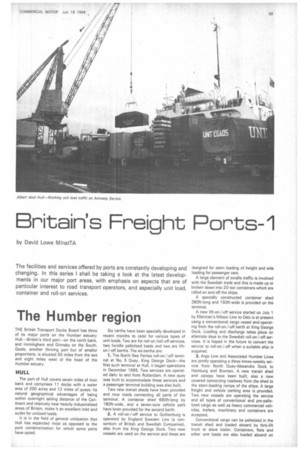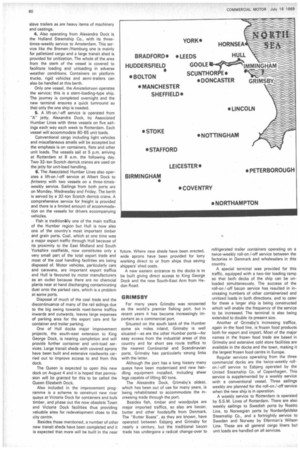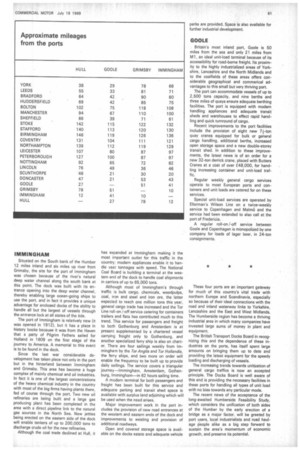Britain's Freight Ports -I
Page 61

Page 62

Page 63

If you've noticed an error in this article please click here to report it so we can fix it.
by David Lowe MInstTA The facilities and services offered by ports are constantly developing and changing. In this series I shall be taking a look at the latest developments in our major port areas, with emphasis on aspects that are of particular interest to road transport operators, and especially unit load, container and roll-on services.
The Humber region
THE British Transport Docks Board has three of its major ports on the Humber estuary: Hull—Britain's third port—on the north bank, and Immingham and Grimsby on the South. Goole, another thriving port but of smaller proportions, is situated 50 miles from the sea and eight miles west of the head of the Humber estuary.
HULL
The port of Hull covers seven miles of river bank and comprises 11 docks with a water area of 200 acres and 12 miles of quays. Its natural geographical advantages of being within overnight sailing distance of the Continent and relatively near heavily industrialized areas of Britain, make it an excellent inlet and outlet for unitized loads.
It is in the field of general unitization that Hull has expanded most as opposed to the pure containerization for which some ports have opted. Six berths have been specially developed in recent months to cater for various types of unit loads. Two are for roll-on /roll-off services, two handle palletized loads and two are lifton I-off berths. The six berths are: 1. The North Sea Ferries roll-on I-off terminal at No. 5 Quay, King George Dock—the first such terminal at Hull, it began operations in December 1965. Two services are operated daily to and from Rotterdam. A new quay was built to accommodate these services and a passenger terminal building was also built.
Two new transit sheds have been provided and new roads connecting all parts of the terminal. A container shed 660ft-long by 180ft-wide, and a seven-acre vehicle park have been provided for the second berth.
2. A toll-on I-off service to Gothenburg is operated by England Sweden Line (a consortium of British and Swedish Companies), also from the King George Dock. Two new vessels are used on the service and these are designed for stern loading of freight and side loading for passenger cars.
A large element of smalls traffic is involved with the Swedish trade and this is made up or broken down into 20-ton containers which are rolled on and off the ships.
A specially constructed container shed 360ft-long and 150ft-wide is provided on the terminal.
A new lift-on I-off service started on July 1 by Ellerman's Wilson Line to Oslo is at present using a conventional cargo vessel and operating from the roll-on /-off berth at King George Dock. Loading and discharge takes place on alternate days to the Swedish roll-on /-off services. It is hoped in the future to convert the service to roll-on /-off when a suitable ship is acquired.
3. Argo Line and Associated Humber Lines are jointly operating a three-times-weekly service from North Quay-Alexandra Dock to Hamburg and Bremen. A new transit shed and canopy have been built, also a new covered connecting roadway from the shed to the stern-loading ramps of the ships. A large freight and vehicle parking area is provided. Two new vessels are operating the service and all types of conventional and pre-palletized cargo as well as heavy commercial vehicles, trailers. machinery and containers are accepted.
Conventional cargo can be palletized in the transit shed and loaded aboard by fork-lift truck or slave trailer. Containers, flats and other unit loads are also loaded aboard on slave trailers as are heavy items of machinery and castings.
4. Also operating from Alexandra Dock is the Holland Steamship Co., with its threetimes-weekly service to Amsterdam. This service like the Bremen /Hamburg one is mainly for palletized cargo and a large transit shed is provided for unitization. The whole of the area from the stern of the vessel is covered to facilitate loading and unloading in adverse weather conditions. Containers an platform trucks, rigid vehicles and semi-trailers can also be handled at this berth.
Only one vessel, the Amstelstroon operates the service; this is a stern-loading-type ship. The journey is completed overnight and the new terminal ensures a quick turnround so that only the one ship is needed.
5. A lift-on /-off service is operated from "A" jetty, Alexandra Dock, by Associated Humber Lines with three vessels on five sailings each way each week to Rotterdam. Each vessel will accommodate 60-65 unit loads.
Conventional cargo including light vehicles and miscellaneous smalls will be accepted but the emphasis is on containers, flats and other unit loads. The vessels sail at 5 p.m. arriving at Rotterdam at 8 a.m. the following day. Two 32-ton Scotch derrick cranes are used on the jetty for unit-load handling.
6. The Associated Humber Lines also operates a lift-on /-off service at Albert Dock to Antwerp with two vessels on a three-timesweekly service. Sailings from both ports are on Monday, Wednesday and Friday. The berth is served by a 32-ton Scotch derrick crane. A comprehensive service for freight is provided and there is a limited amount of accommodation on the vessels for drivers accompanying vehicles.
Fish is traditionblly one of the main traffics of the Humber region but Hull is now also one of the country's most important timber and grain ports. Coal, which at one time was a major export traffic through Hull because of its proximity to the East Midland and South Yorkshire coalfields, now constitutes only a very small part of the total export trade and most of the coal handling facilities are being disposed of. Motor vehicles, particularly cars and caravans, are important export traffics and Hull is favoured by motor manufacturers as an outlet because there are no chemciai plants near at hand discharging contaminating dust onto the parked cars, which is a problem at some ports.
Disposal of much of the coal trade and the discontinuance of many of the rail sidings due to the big swing towards road-borne traffics inwards and outwards, leaves large expanses of parking area for the export 'cars and for container and trailer parking.
One of Hull docks major improvement protects, the south-east extension to King George Dock, is nearing completion and MI provide further container and unit-load services. Large transit sheds with covered aprons have been built and extensive roadworks carried out to improve access to and from this dock.
The Queen is expected to open this new dock on August 4 and it is hoped that permission will be granted for this to be called the Queen Elizabeth Dock.
Also included in the improvement programme is a scheme to construct new river quays at Victoria Dock for containers and bulk timber, and phase out the now obsolete Town and Victoria Dock facilities thus providing valuable sites for redevelopment close to the city centre.
Besides those mentioned, a number of other new transit sheds have been completed and it is expected that more will be built in the near future. Where new sheds have been erected, wide aprons have been provided for lorry working direct to or from ships thus saving shippers' shed costs.
A new eastern entrance to the docks is to be built giving direct access to King George Dock and the new South-East Arm from Hedon Road.
GRIMSBY
For many years Grimsby was renowned as the world's premier fishing port, but in recent years it has become increasingly important as a commercial port.
Situated on the south bank of the Humber some six miles inland, Grimsby is well
situated as are the other Humber ports—for easy access from the industrial areas of this country and for short sea route traffics to the nearest Continental and Scandinavian ports. Grimsby has particularly .strong links with the latter.
Although the port has a long history many quays have been modernized and new handling equipment installed, including sheer legs capable of lifting 60 tons.
The Alexandra Dock, Grimsby's oldest, which has been out of use for many years, is being rehabilitated to accommodate the increasing trade through the port.
Besides fish, timber and woodpuIps are major imported traffics, so also are bacon, butter and other foodstuffs from Denmark. The "Butter Boats", as they are known, have operated between Esbjerg and Grimsby for nearly a century, but the traditional bacon trade has undergone a radical change-over to refrigerated trailer containers operating on a twice-weekly roll-on /-off service between the factories in Denmark and wholesalers in this country.
A special terminal was provided for this traffic, equipped with a two-tier loading ramp so that both decks of the ship can be unloaded simultaneously. The success of the roll-on /-off bacon service has resulted in increasing numbers of other containerized and unitized loads in both directions, and to cater for these a larger ship is being constructed which will enable the frequency of the service to be increased. The terminal is also being extended to double its present size.
Another of Grimsby's increasing traffics, again in-the food line, is frozen food products both for export and import. Most of the major names in the frozen food trade are based in Grimsby and extensive cold store facilities are available in the docks and the town, making it the largest frozen food centre in Europe.
Regular services opera-Mg from the three commercial docks are the twice-weekly rollon /-off service to Esbjerg operated by the United Steamship Co. of Copenhagen. This service is supplemented by a weekly service with a conventional vessel. Three sailings weekly are planned for the roll-on /-off service when the new ship is in operation.
A weekly service to Rotterdam is operated by S.S.M. Lines of Rotterdam. There are also weekly sailings to Swedish ports by Nostro Line, to Norwegian ports by Nordenfjeldske Steamship Co., and a fortnightly service to Sweden and Norway by Ellerman's Wilson Line. These are all general cargo liners but unit loads are handled on all services.
IMMINGHAM
Situated on the South bank of the Humber 12 miles inland and six miles up river from Grimsby, the site for the port of Immingham was chosen because of the river's natural deep water channel along the south bank at this point. The dock was built with its entrance opening into the deep water channel, thereby enabling large ocean-going ships to use the port, and in fact it provides a unique advantage for enclosed docks of the ability to handle all but the largest of vessels through the entrance lock at all states of the tide.
The port of Immingham is relatively new lit was opened in 1912), but it has a place in history books because it was from the Haven that a party of Pilgrim Fathers sailed for Holland in 1609 on the first stage of the journey to America. A memorial to this event is to be found in the dock.
Since the last war considerable development has taken place not only in the port but in the hinterland between Immingham and Grimsby. This area has become a huge complex of mainly chemical and oil industries. In fact it is one of the largest concentrations of the heavy chemical industry in the country with most of the big firms having plants there, fed of course through the port. Two new oil refineries are being built and a large gas producing plant has been completed in the area with a direct pipeline link to the natural gas sources in the North Sea. New jetties being erected on the eastern side of the dock will enable tankers of up to 200,000 tons to discharge crude oil for the new refineries.
Although the coal trade declined at Hull, it has expanded at Immingham making it the most important outlet for this traffic in the country: modern appliances enable it to handle vast tonnages with speed. The National Coal Board is building a terminal at the western end of the dock to handle coal shipments in carriers of up to 65,000 tons.
Although most of Immingham's through traffic is bulk cargo, chemicals, woodpulps, coal, iron and steel and iron ore, the latter expected to reach one million tons this year, general cargo trade has increased and the Tor Line roll-on I-off service catering for containers trailers and flats has contributed much to this trend. This service for passengers and freight to both Gothenburg and Amsterdam is at present supplemented by a chartered vessel carrying freight only to Gothenburg, and another specialized ferry ship is also on charter. There are four sailings weekly from Immingham by the Tor Anglia and Tor Hollandia, the ferry ships, and two more on order will enable the frequency to be built up to provide daily sailings. The service covers a triangular journey—Immingham, Amsterdam, Gothenburg, Immingham—in 62 hours sailing time.
A modern terminal for both passengers and freight has been built for this service and adequate parking and transit shed space is available with surplus land adjoining which will be used when the need arises.
Major improvement work in the port includes the provision of new road entrances at the western and eastern ends of the dock and improvements to existing and provision of additional roadways.
Open and covered storage space is available on the docks estate and adequate vehicle parks are provided. Space is also available for further industrial development.
GOOLE
Britain's most inland port, Goole is 50 miles from the sea and only 21 miles from Ml, an ideal unit-load terminal because of its accessibility for road-borne freight. Its proximity to the highly industrialized areas of Yorkshire, Lancashire and the North Midlands and to the coalfields of these areas offers considerable geographical and commerical advantages to this small but very thriving port.
The port can accommodate vessels of up to 2,500 tons capacity, and nine berths and three miles of quays ensure adequate berthing facilities. The port is equipped with modern handling appliances and adequate transit sheds and warehouses to effect rapid handling and quick turnround of cargo.
Recent improvements to the port facilities include the provision of eight new 'fly-ton quay cranes equipped for bulk or general cargo handling, additional berths, increased open storage space and a new double-storey transit shed. In addition to these improvements, the latest news is of an order for a new 32-ton derrick crane, placed with Butters Cranes at a cost of over £48,000, for handling increasing container and unit-load traffic, Regular weekly general cargo services operate to most European ports and containers and unit loads are catered for on these services.
Special unit-load services are operated by Ellerman's Wilson Line on a twice-weekly service to Copenhagen and Malmo and the service had been extended to also call at the port of Fredericia.
A regular roll-on I-off service between Goole and Copenhagen is Monopolized by one company for loads of lager beer, in 24-ton consignments.
These four ports are an important gateway for much of this country's vital trade with northern Europe and Scandinavia, especially so because of their ideal connections with the road and inland waterway links to Yorkshire, Lancashire and the East and West Midlands. The Humberside region has become a thriving industrial area in which many companies have invested large sums of money in plant and equipment.
The British Transport Docks Board in recognizing this and the dependence of these industries on the ports, has itself spent large amounts on bringing them up to date and providing the latest equipment for the speedy loading and discharging of vessels.
The increasing trends towards unitization of general cargo traffics is now an accepted -principle. The Docks Board is well aware of this and is providing the necessary facilities in these ports for handling all types of unit load with no bias towards any particular mode.
The recent news of the acceptance of the long-awaited Humberside Feasibility Study, which considers the unification of both sides of the Humber by the early erection of a bridge as a major factor, will be greeted by port users, local industrialists and road haul age People alike as a big step forward to sustain the area's momentum of economic growth, and preserve its potential.
















































































































